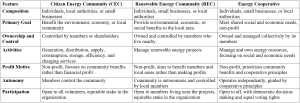Introduction
As the shift towards renewable energy accelerates, different types of energy communities have emerged, each with distinct characteristics and benefits. Understanding these distinctions is crucial for anyone looking to participate in or support renewable energy initiatives. In this blog, we will explore the differences between Citizen Energy Communities (CECs) and Renewable Energy Communities (RECs), highlighting their unique features and contributions to the energy landscape.

Types of energy communities
Energy Communities can take on various forms, each tailored to specific goals, governance structures, and community needs. These types include:
- Citizen Energy Communities (CECs)
- A Citizen Energy Community (CEC) is a group made up of individuals, local authorities, or small businesses that work together voluntarily to manage energy activities.
- The primary goal of a CEC is to benefit the environment, economy, or local community rather than to make a profit.
- CECs can be involved in energy generation (especially from renewable sources), distribution, supply, consumption, and other services like energy storage, efficiency, or electric vehicle charging.
- Control of the community remains with its members or shareholders (1).
- Renewable Energy Communities (RECs)
- A Renewable Energy Community (REC) is a group made up of individuals, small businesses, or local authorities that voluntarily come together to manage renewable energy projects.
- The communities’ members who live near these projects own and take control of the RECs.
- RECs aim to provide environmental, economic, or social benefits to its members, rather than to generate profits. The community is autonomous and run by its members (2).
- Energy Cooperatives
- An Energy Cooperative is a non-profit organization where members collectively own and manage energy resources, focusing on meeting shared social and economic needs. It operates on cooperative principles like volunteerism, democracy, and equality.
- Membership is open to all, and decisions are made democratically, with each member having an equal vote. Members contribute to and benefit from the cooperative based on their participation.
- Energy cooperatives are independent, educate their members, and collaborate with other cooperatives. Additionally, they prioritize ethical practices to support and improve their local communities (3).
Differences Between Citizen Energy Communities and Renewable Energy Communities and Energy Cooperatives

To illustrate, CECs emphasize the active involvement of their members in managing and benefiting from various energy activities. In contrast, RECs focus on managing renewable energy projects with a primary goal of providing environmental and social benefits, sometimes with less emphasis on local participation. Energy Cooperatives, on the other hand, are non-profit organizations that collectively manage energy resources with a strong focus on meeting shared social and economic needs.


Leave a Reply